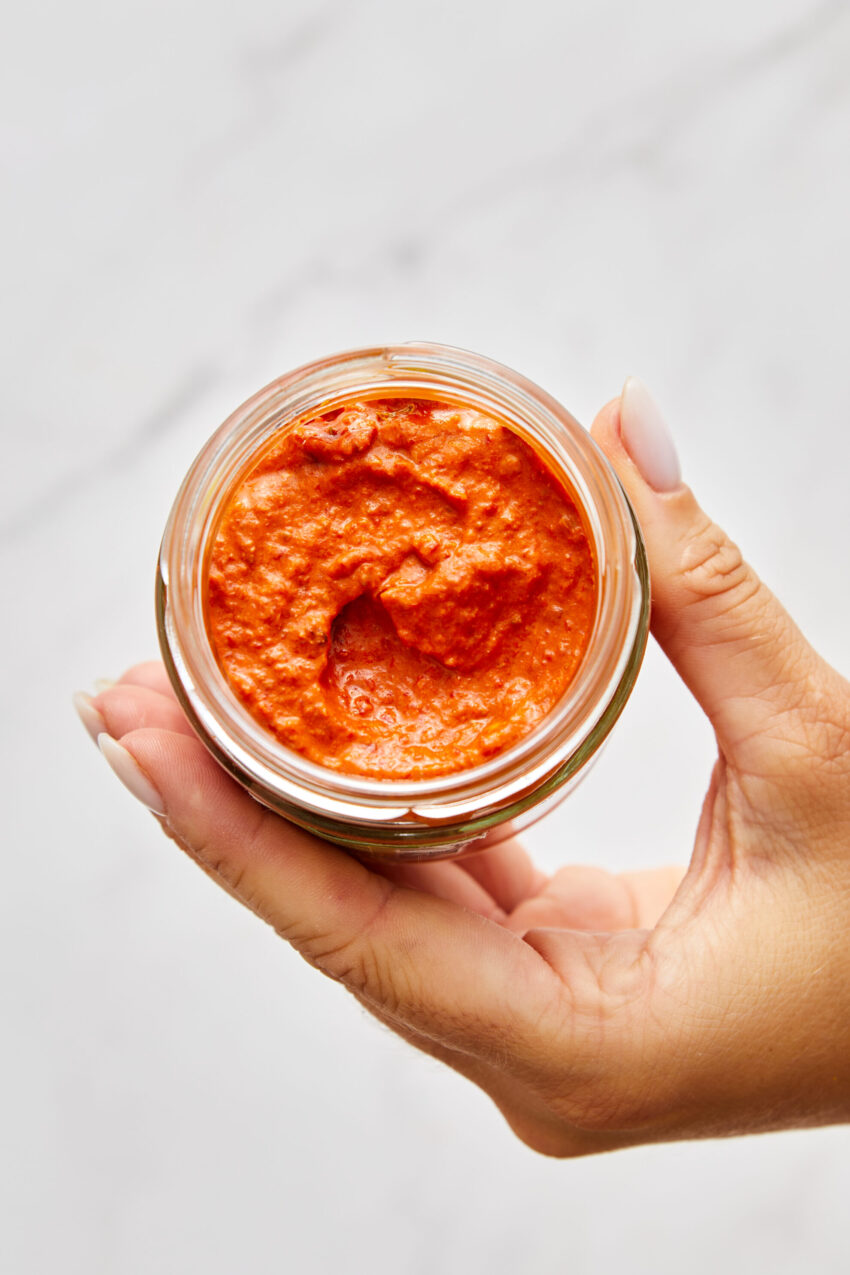Harissa Recipe

Smoky, spicy, fruity and tangy, this spread will show you a Tunisian good time.

I lived with three roommates in the Lower Haight district of San Francisco for four years, including the first year of the pandemic. We banded together with nightly family dinners, 5 PM cocktail hour and an unbroken streak of 60 nights of homemade desserts. Roxie was the king of pickling, always testing out peppers, vinegars and spices to see what would go best with his sourdough baking (the global sourdough craze of 2020 invaded our house too). Wearing his apron and urging us to call him “Abuelita”, he eventually made harissa paste from scratch, soaking, roasting and grinding peppers and seeds. After several rounds of Manhattans, the four of us consumed several loaves of homemade sourdough slathered with homemade harissa, killing the whole jar that night.
Harissa has its roots in the Maghreb, also known as North Africa. Locals there for centuries smashed peppers and spices to create this rich spread. Nowadays Tunisia is the biggest exporter of jarred harissa, and the United Nations Educational, Scientific and Cultural Organization (UNESCO) has listed it as part of Tunisia’s Intangible Cultural Heritage.
The name harissa is derived from the word harasa, the Arabic verb meaning “to crush” or “to pound”. Tunisia uses the spicy dip as an ingredient in meat and fish stews and to flavor couscous. Algeria uses it as a rub for eggplant, Libya layers it on egg dishes, Israel eats it as a topping on shawarma beef wraps and Morocco prefers a less-seasoned version for their tagines (a type of stew). The UNESCO designation helps to explain its rich cultural history, as Tunisian families lovingly recall laying out chiles to dry in the sun and making large vats of the paste together as a family.
Harissa is TASTY, a spicy and smoky blend of peppers, seeds, spices, juice and oil to create this savory, creamy spread with just a hint of sweet and a bit of fruity. A little goes a long way, so keep your spice radar finely tuned if you are sensitive. It is truly a one-of-a-kind flavor, nothing can replicate it.
Is Harissa Paste Healthy?
Health-wise, you’ve just stumbled onto a winner. No preservatives, no sugar, no dairy, this is the real deal to get your dip fix. Olive oil is, of course, the healthiest of all oils, red chilies are rich in vitamins and antioxidants, garlic has anti-inflammatory properties, and lemon juice provides vitamin C. The health benefits of harissa mean you have finally found a dip you can enjoy without the creamy calories of hummus or Lipton’s sour cream and onion dip. (Though, those are still fatty amazing!)
Who’s a Pepper?
While we recommend New Mexico or Guajillo peppers, harissa can be made several different ways with a variety of peppers. Tunisians use roasted red peppers and Baklouti peppers. Named after Bekalta, a city on the Tunisian coast, Baklouti peppers provide the mild, smokiness that defines the paste. However, if your usual market does not carry Baklouti peppers, New Mexico or Guajillo will heat and smoke up your dip perfectly.
INGREDIENTS
- 4 ounces dried chiles (such as New Mexico or Guajillo)
- 1 teaspoon caraway seeds
- 1 teaspoon coriander seeds
- 1 teaspoon cumin seeds
- 4 cloves garlic, peeled
- 1 teaspoon kosher salt
- 2 tablespoons extra virgin olive oil
- 1 tablespoon fresh lemon juice

INSTRUCTIONS
Soften
Soak chiles in hot water.
Grind
Toast and grind spices.
Blend
Combine all ingredients in a food processor to form a paste.
Devour!

FAQs & Tips
When storing your harissa paste, use a clean mason jar and cover it with a very thin layer of extra virgin olive oil before sealing the jar. Refrigerate the jar, and the paste will last for 2 to 3 weeks. Each time you use the paste, add olive oil to cover the top before storing it back in the fridge. The extra drizzles of olive oil will make it creamier.
While I love testing how far I can go with a spicy heat challenge, my mother can’t handle it. If you have any spice sensitivities, try gradually adding the peppers to control the spiciness. Taste test throughout, that way you can control just how much heat is going to wallop your taste buds.

Serving Suggestions
Tunisians eat harissa on everything from fish to eggs to bread. It is mixed into hummus and mayonnaise, used as a marinade for beef and lamb and folded into stews. Serve as a dip with pita bread and vegetables, or stir into rice to give an extra bite. No wrong way to eat harissa.
For more harissa inspiration, try Harissa Aioli. For keeping with your Maghreb meal theme, try this Classic Shakshuka Recipe. Or make some Homemade Falafel and drizzle your harissa on top.


Harissa Recipe
Ingredients
- 4 ounces dried chiles such as New Mexico or Guajillo
- 1 teaspoon caraway seeds
- 1 teaspoon coriander seeds
- 1 teaspoon cumin seeds
- 4 cloves garlic peeled
- 1 teaspoon kosher salt
- 2 tablespoons extra virgin olive oil
- 1 tablespoon fresh lemon juice
Instructions
- Soften the chiles by placing them in a heatproof bowl and covering them with boiling water. Let stand for 30 minutes.

- Toast the caraway, coriander, and cumin seeds in a dry skillet over medium heat until fragrant, about 3 minutes. Grind the spices using a mortar and pestle or spice grinder.

- Drain the chiles, remove and discard the stems and seeds. Combine the chiles, ground spices, garlic, and salt in a food processor. Process while slowly adding olive oil and lemon juice until a smooth paste forms.

Nutrition
The post Harissa Recipe appeared first on Food Faith Fitness.





